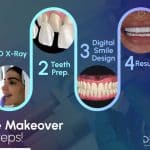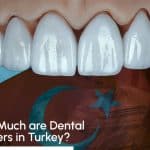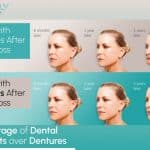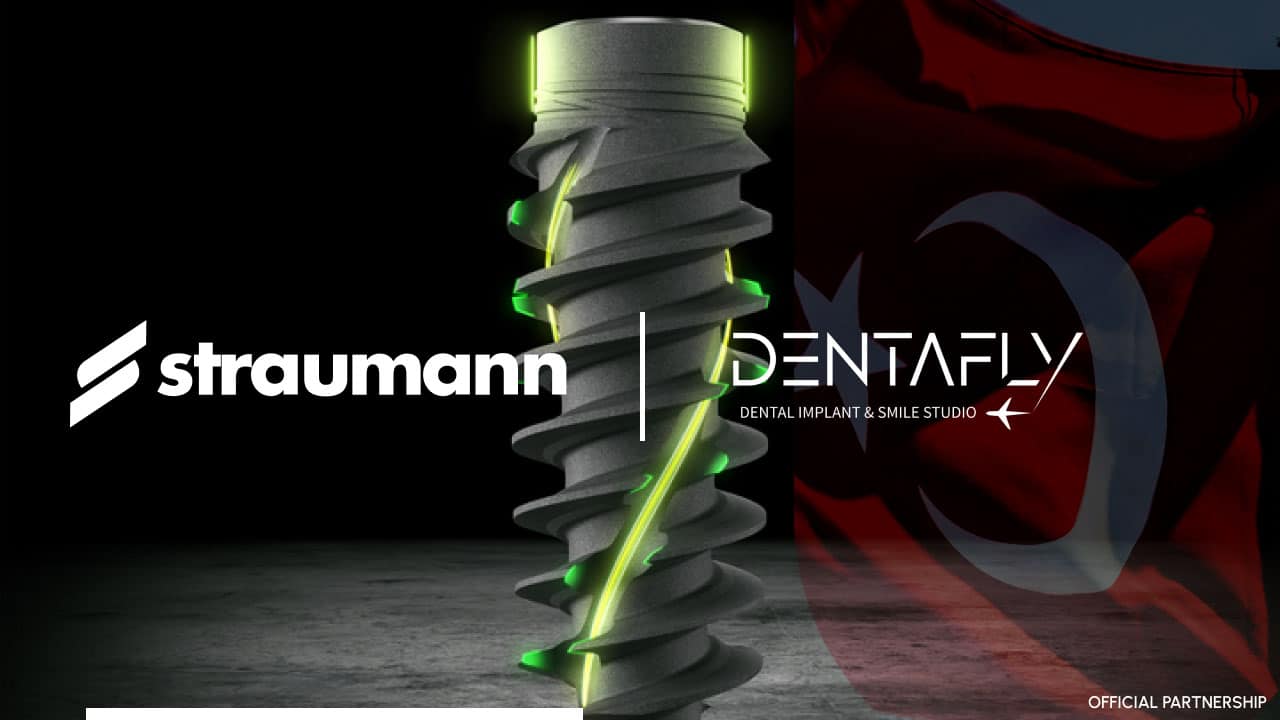Digital Dentistry is carrying dental treatments with the help of digitised computer systems to aid the dental treatment of the patient to the dental prosthetic dentists or dental implant surgeons. Digital Dentistry refers to the use of computer-aided systems to carry out the full dental treatment process of the patient. The use of digital dentistry will increase the efficiency and speed of the dental treatment process as well as the devices such as 3D X-Ray (What is 3D X-Ray in dental treatment) will help with the diagnosis for the dental treatment of the patient. Digital dentistry will help with the restoration and diagnosis to ensure the mouth health and function system is impeccable.
Different case usage of Digital Dentistry
Digital Dentistry has transformed to reach out every aspect of dentistry to bring the modern era of technology into dentistry. Digital Dentistry is used from diagnosis to perfectly execute the dental treatment that is designed individually for the patient. Digital dentistry can be used to locate a simple decay to the jawbone quality, jawbone density, jawbone length, jawbone width, and general jawbone size to locate the best place for a dental implant placement.
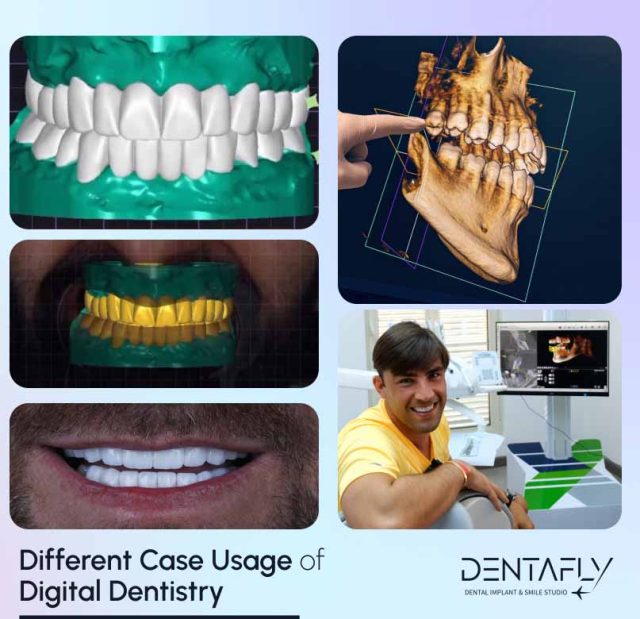
Tools that are being used in Digital Dentistry
Intraoral Cameras
Instead of regular mirrors that dentists are using to check the inside of the patients’ mouth, intraoral cameras are replacing the old technology mirrors. A dentist can use intraoral cameras for many different purposes. Intraoral cameras are helpful with:
- Making better diagnostic
- A small decay on the patient’s tooth can be zoomed to be seen better in an enhanced quality for better diagnosis
- Oral hygiene of the patient can be seen and any issue such as:
- Gum disease
- Periodontal disease
- Creating a better treatment plan
- Having the 3D image of the patient’s mouth will increase the success of the dental treatment diagnosis and solution
- The dentist will be able to make a certain diagnosis
- Scanning
- The dentist will use the Intraoral cameras to take a digital scan, instead of taking impressions via using moulds that are making patients gag and quite uncomfortable.
- The scan will be helpful with:
- Creating the correct biting position for dental crowns, dental laminate veneers, dental full veneers,
- Creating the correct biting position for fixed and aesthetic temporary teeth for the patients with All on System Full Mouth Dental Implants
- General design of the new teeth of the patient.
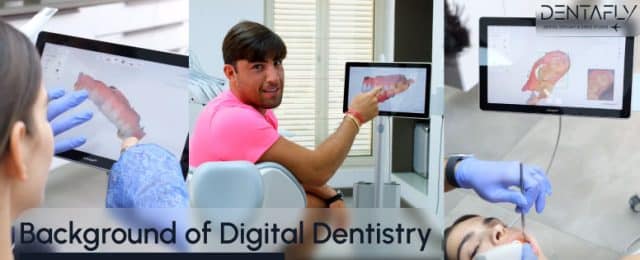
Here at Dentafly Dental Implant and Smile Studio in Antalya/Turkey, we are specifically working with the 3Shape brand. 3Shape is a computer system incorporating cutting-edge CAD-CAM technology. Using special cameras, the condition of the tooth to be restored is checked and measurements are taken, and the data acquired is then transferred to the 3D digital environment. Our dentists will then create a dental design digitally according to the patient’s wishes. Utilising the 3Shape system, it is possible to create a lasting, new smile quickly.
The Process of Wisdom Teeth Extraction: An Overview with Dentists
How digital dentistry leads dental treatments at Denta Fly Antalya?
The Process of Wisdom Teeth Extraction: An Overview with Dentists
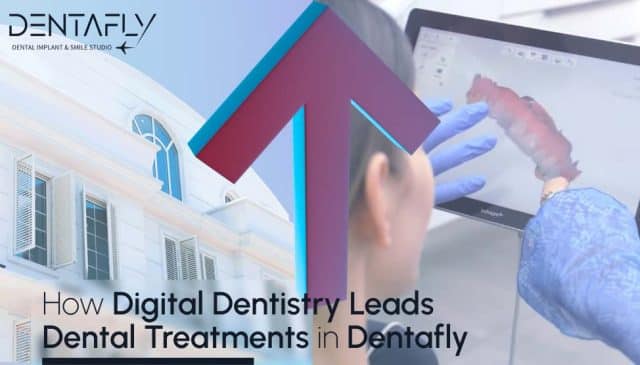
Digital X-ray Systems
Digital X-Ray Systems are indispensable when it comes to dental treatments and diagnosis to create suiting dental treatment plans. A naked eye can see so far. Digital X-Ray Systems are a dentist’s radar to find where the problem is located.
Prices for digital dentistry in 7 days
A 2D Panoramic X-Ray will provide to the examination dentist and the dental implants surgeon weather or not:
- the patient has a cavity,
- The patient needs a root canal treatment,
- The patient is experiencing a bone loss,
- The patient is experiencing a hanging sinus gap,
- The teeth of the patient are being held by the jawbone strongly.
All of these will help the dentist and the dental implant surgeon to create a fitting and healthy plan. The created plan will be carried out as the dental treatment of the patient. The 2D Panoramic X-Ray will be used before dental treatment of the patient, which is consultation, and during the dental treatment.
A Digital 3D X-ray can provide the examination dentist and the dental implant surgeon with extra information that a 2D Panoramic X-Ray cannot. These can be used for:
- Orthodontic procedures
- Planning dental implant placement for the damaged teeth
- Diagnosis of the temporomandibular joint dysfunction
- Finding the strong slice of the bone for placement of the implant(s)
- Locating the origin of pain or a disease
- Finding, measuring, and treating jaw bone tumours
- Collecting data for the bone structure and health
- Reconstructive surgery for the jaw and dental implants
- Planning for root canal treatment, sinus lift, and bone graft
A 3D X-ray is much more efficient compared to the 2D Panoramic X-Ray. A 3D X-Ray can provide:
- Versatile imaging system
- 3D interactive image
- Advanced measurement system of the
- Jawbone density
- Jawbone length
- Jawbone width
- Jawbone quality
All these measurements are necessary are to decide the best fitting dental implant size
- Measuring whether or not the patient will need a sinus lift
- A sinus lift can be a “closed” or “open” depending on the amount of sinus is hanged and/or the level of bone loss
- Nerve canals of the patient can be seen better to avoid during dental implant placement.
- Better visual and measuring the size of:
- Infection
- Cyst
- Root
- Bone
With the usage of Digital Imaging Systems, the dentists are able to easily:
- Diagnose
- Explain to the patient, and
- Execute the dental treatment
The Digital Imaging Systems are reducing the risk of any failure possibility of the dental treatment that is going to be carried out for the patient.
CAD/CAM Dentistry
CAD/CAM technology was introduced to dentistry toward the late 20th century. With the advancements in general technology, Computer-aided design (CAD) and computer-aided manufacturing (CAM) have revolutionised the field of digital dentistry in recent years. These technologies allow dental professionals to design and manufacture custom dental restorations and prosthetics with greater accuracy and efficiency than ever before. CAD/CAM allows the dentists to provide accurate solutions to the patients with complex restorative requests or complex restorative problems.
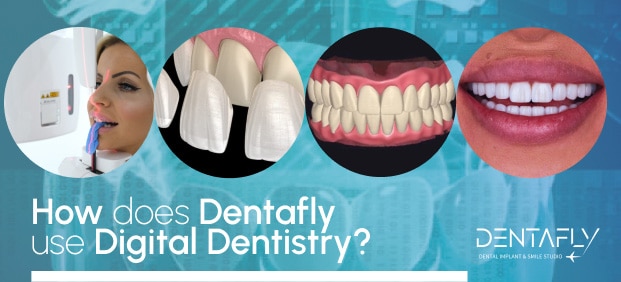
CAD/CAM technology in digital dentistry provides a range of benefits, including:
- Customization: CAD software allows dental professionals to create digital 3D models of dental restorations that are tailored to the individual patient’s mouth, rather than relying on pre-fabricated or “one size fits all” options. This leads to improved patient satisfaction and better long-term outcomes for dental treatments.
- Accuracy: By using 3D modelling and scanning technologies, dental professionals can create restorations with greater accuracy and precision than ever before. This can lead to better fitting restorations and fewer complications during treatment.
- Efficiency: CAD/CAM technology can significantly reduce the time and labour required to create dental restorations. It allows dental professionals to design and manufacture custom restorations quickly and easily, without the need for traditional hand-sculpting techniques.
- Versatility: CAD/CAM technology can be used to create a wide range of dental restorations, including crowns, bridges, implants, and more. It can also be used to create guides for implant placement and other procedures, helping to improve accuracy and reduce the risk of complications.
- Durability: Restorations created using CAD/CAM technology are typically made of durable materials such as porcelain, zirconia, or acrylic resin. This can help to ensure that they are long-lasting and able to withstand the rigours of everyday use.
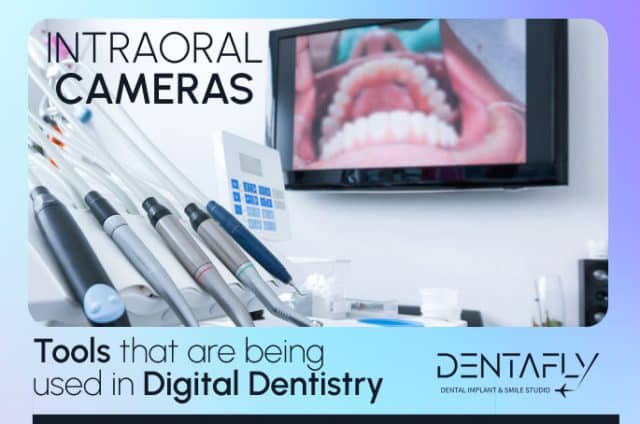
One of the main benefits of CAD/CAM in digital dentistry is the ability to create precise and accurate restorations. Traditional dental restorations were often created using manual techniques, which were prone to errors and required multiple visits to the dentist. With CAD/CAM, the design and manufacturing process is streamlined, resulting in more accurate and efficient treatment.
CAD/CAM technologies are used in a variety of dental procedures, including crowns, bridges, inlays, onlays, and veneers. These technologies allow dentists to create highly accurate digital models of a patient’s mouth, which can then be used to design and fabricate custom dental restorations.
Overall, CAD/CAM technology in digital dentistry provides a range of benefits that can improve the accuracy, efficiency, and customization of dental treatments.
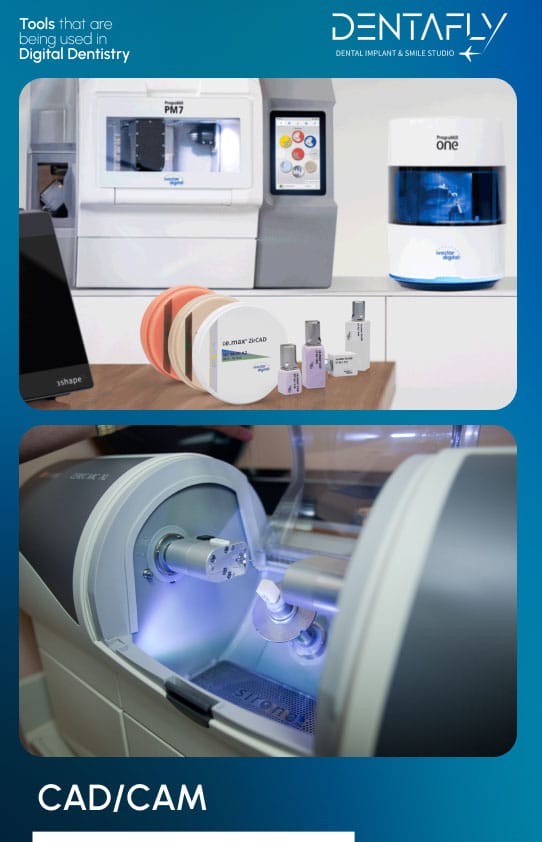
Here at Dentafly Dental Implants and Smile Studio, we are using the best, top of the dentistry level CAD/CAM machines such as Ivoclar’s PMI 7 (what are the advantages of Ivoclar PMI 7? ). Combining Digital Dentistry with Ivoclar’s PMI 7 milling machine, we are able to produce fast and accurate dental crowns, dental laminate veneers, and dental full veneers. Our patients do not have to travel to Antalya/Turkey often. With one visit, we will complete the dental treatment of the patient with the best fit either dental laminate veneer, dental full veneer, or dental crowns. Patients will not have to come more than once for such treatment.
Digitally Guided Dental Implant System
Digitally guided dental implant systems are using intraoral cameras, 3D X-Ray, and its own camera for visuals to locate the best location for the dental implant to be placed in the jawbone of the patient.
Using Digitally Guided Dental Implant System:
- Reduces the chance of human errors
- Performs the dental implant placement flapless
- This means that there will be no blood
- The accuracy of the dental implant placement is being made with
- fStatic Guides, and
- Dynamic Navigation
- Unnecessary incisions are avoided thus the recovery time is reduced
- Compatible with many different dental implant systems such as:
How does Dentafly use Digital Dentistry?
Dentafly Dental Implants and Smile Studio is working with fully capable Digital Dentistry equipment and laboratory that is focused on Digital Dentistry. We are using Digital Dentistry for all of our patients to make them happy with the smile that they dream while designing their healthy mouth function for their comfort for the rest of their lives.
Get Digital Dentistry Price List PDF
Here at Dentafly Dental Implants and Smile Studio, we are using Digital Dentistry as:
- CAD/CAM: Computer-aided design/computer-aided manufacturing (CAD/CAM) systems can be used to create digital models of teeth and jaws, which can be used to design and fabricate custom restorations such as crowns, bridges, and veneers.
- Digital X-rays: Digital X-rays use sensors to capture images of the teeth and jaws, which can be displayed on a computer screen. They produce less radiation than traditional film X-rays and can be easily stored and shared digitally.
- Digital impressions: Digital impressions use 3D scanners or intraoral cameras to create digital models of the teeth and jaws, eliminating the need for physical impressions.
- Laser dentistry: Laser dentistry uses focused beams of light to remove or reshape tissue, making it a less invasive alternative to traditional tools such as drills or scalpels.
- Virtual consultations: Virtual consultations allow dental professionals to interact with patients remotely, using video conferencing or other digital tools.
- Telehealth: Telehealth platforms enable dental professionals to provide care remotely, using phone or video consultations, digital prescribing, and other technologies.
Dentafly’s aim is to ensure the health, satisfaction, and speed of our patients’ dental treatments here in Antalya/Turkey at Dentafly Dental Implants and Smile Studio.
How does Dentafly use Digital Dentistry
We are carrying all of the dental treatment here at Dentafly Dental Implant and Smile Studio in Antalya/Turkey with the use of Digital Dentistry. The steps of Digital Dentistry it Dentafly Dental Implants and Smile Studio in Antalya/Turkey is different for dental implant patients and dental laminate veneer, dental full veneer, and dental crowns. They are mostly the same but of course, dental implant in Turkey at Dentafly Dental Implant and Smile Studio requires 2 visits due to the need of healing period. The steps are considered after the consultation is completed and the dental treatment of the patient is set, the dental treatment will begin.
| Dental crowns, dental laminate and full veneers treatment | Dental implants All on System treatment | Dental implants treatment |
|
||
| The preparation of the teeth will begin. Thanks to Digital Dentistry, we are not required to shave down the teeth of the patient like the old technology. We require between 0.3 to 0.8mm preparation. | The implant surgeon will extract teeth for All on System | The implant surgeon will extract any teeth if they are blocking the dental treatment |
| After the preparation, the dentist will use the intraoral camera to take a digital impression of the patient’s mouth. | The dental implant surgeon will place the dental implants and if there is any need, sinus lift and bone graft will be done at the same time | The dental implant surgeon will place the dental implants and if there is any need for sinus lift and bone graft |
| The dentist will cover the patient’s teeth with protective material so that the patient does not feel any sensitivity | The dental implant surgeon will decide whether to bury the dental implant and will use suture to ensure the safety and health of the dental implant | The dental implant surgeon will decide whether to bury the dental implant and will use suture to ensure the safety and health of the dental implant |
| 2. Second appointment | ||
| The dentist will rehearse the temporary teeth that is designed in our laboratory with CAD/CAM machines according to the patient’s design and shape requests | The dental implant surgeon will take digital scan of the mouth of the patient to start the preparation for the fixed and aesthetic temporary teeth using computer systems to design and CAD/CAM to produce | Depending on the dental treatment, the patient will come for a check-up and that will be the final. If the dental treatment involves crowns, teeth will be prepared and a digital scan of the mouth of the patient will be taken to start preparation for the fixed and aesthetic temporary teeth using computer systems to design and CAD/CAM to produce |
| 3.Third appointment | ||
| The patient will rest while the dental crowns, dental full veneers, or the dental laminate veneers are being prepared using a digital computer design programme, CAD/CAM machine to carve the shape and design, and Digital Furnace to cook the material until it is ready. | The dental implant surgeon will place the fixed and aesthetic temporary teeth and the patient will try them on. | The dental implant surgeon will place the fixed and aesthetic temporary teeth and the patient will try them on. |
| 4. Fourth appointment | ||
| The Digital Monolithic Glass-Ceramic Zirconia Crowns or Digital IPS E.max CAD/CAM Lithium Disilicate Veneers, or the Digital IPS E.max CAD/CAM Lithium Disilicate full Veneers will be cemented on the patient’s teeth. | The patient will try the fixed and aesthetic temporary teeth before their final check-up appointment to see if there is anything that is bothering. | The patient will try the fixed and aesthetic temporary teeth before their final check-up appointment to see if there is anything that is bothering. |
| 5. Fifth appointment | ||
| The patient will come for their fifth appointment for a short check-up before they leave. | The patient will come for their fifth appointment for a short check-up before they leave. | The patient will come for their fifth appointment for a short check-up before they leave. |
As it is seen, each step involves Digital Dentistry equipment. The implant surgeon works with 3D X-ray and 2D Panoramic X-Ray and the dentist is using an intraoral camera to scan the mouth of the patient to send the laboratory’s design team the correct biting and occlusion position for the designers to work around the aesthetic.

